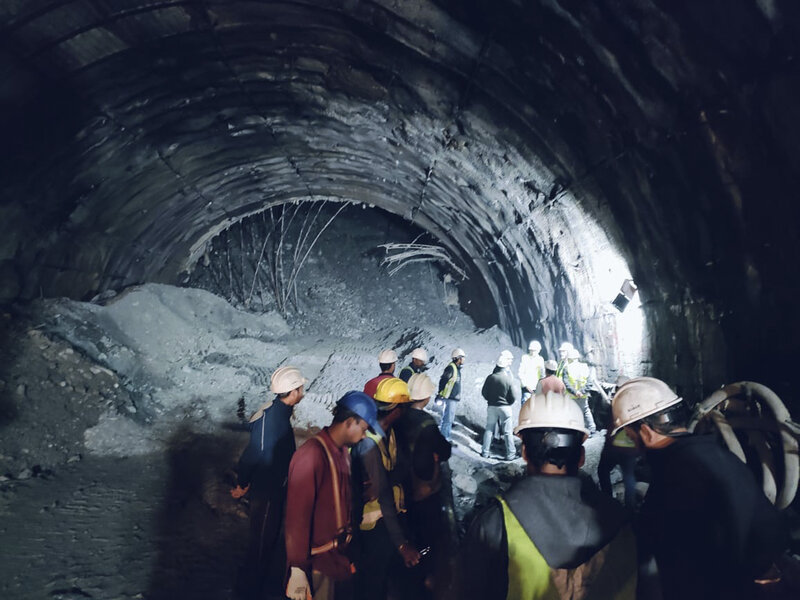India tunnel collapse: Rescuers try to free workers, questions mount
Loading...
| Lucknow, India
Rescue workers on Nov. 14 battled to reach 40 Indian workers trapped inside a collapsed Himalayan highway tunnel for almost 60 hours, drilling through debris to fix a wide steel pipe which they hope can be used to pull the men out.
The trapped men are safe and healthy, authorities said, and are being supplied food, water and oxygen through a pipe. Officials are also in regular contact with them.
The 4.5 km (3 mile) tunnel, which is being built in Uttarakhand state on a national highway that is part of the Char Dham Hindu pilgrimage route, caved in around 5:30 a.m. on Nov. 12.
There were about 50-60 workers on the night shift and those near the exit of the tunnel got out, while the 40 who were deeper inside were trapped, one worker able to leave the tunnel told local media.
“This is a very challenging job because as we clear debris more debris is falling from the ceiling, so we are also trying to stop that by using cement,” Mohsen Shahidi, a senior National Disaster Response Force officer, told news agency ANI.
The debris covered an area of 40 meters (130 ft) and the 40 men were stuck in an area of about 50-60 meters, Mr. Shahidi said.
Devendra Singh Patwal, a state disaster management official, said rescue workers had built a platform to insert the evacuation pipe and drilling had begun to push it through.
Mr. Patwal said it was not easy to say how long it would take to pull out the workers. A team of geologists had arrived to determine the cause of accident, he added.
The region is prone to landslides, earthquakes, and floods, and the incident follows events of land subsidence that geologists, residents, and officials have blamed on rapid construction in the mountains.
The work on the tunnel stretch commenced in 2018 and was intended to be completed by July 2022 – but has now been delayed to May 2024, a government statement said.
Controversial project
“Initially, we thought it might be a minor collapse and began removing the debris however we could,” Rajeev Das, the worker who made it out safely, told the Indian Express newspaper.
Ramesh Kumar, the father of a trapped worker Akhilesh Kumar, said he had last spoken to his son three days before the incident and Akhilesh had planned to visit the family for the Hindu festival of Diwali over the weekend but could not make it.
“His wife is several weeks pregnant and we have not told her as she is already worried and stressed,” Mr. Kumar said.
The Char Dham highway is one of the most ambitious projects of Prime Minister Narendra Modi’s government. It aims to connect four revered pilgrimage sites through 889 km (551 miles) of two-lane road being built at a cost of $1.5 billion.
The project has faced criticism from environmental experts and some work had been halted after hundreds of houses were damaged by subsidence along the routes.
The impact of the project was not properly assessed before construction started, a report by a Supreme Court-appointed expert committee had said in July 2020.
When it approved the road in 2021, the court cautioned that the government should heed concerns raised by the committee, and draw up a strategy to protect the environment.
The head of the panel quit last year saying he was frustrated its recommendations were not implemented.
The federal government has publicly said it employed environmentally friendly techniques in the design to make geologically unstable stretches safer.
Uttarakhand sees a huge flow of pilgrims and tourists every year to visit the temples, with the numbers expanding over the years due to the continuous construction of buildings and roadways, according to The Associated Press.
In January, state authorities moved hundreds of people to temporary shelters after a temple collapsed and cracks appeared in over 600 houses because of the sinking of land in and around Joshimath town in the region, the AP reported.
Uttarakhand Chief Minister Pushkar Singh Dhami on Nov. 14 told ANI that the state would examine work at all tunnels under construction to ensure they are completed safely.
This story was reported by Reuters. Material from The Associated Press was used in this report.







